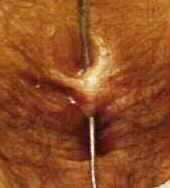Anal Rectal Abscess & Fistula
Anal Abscess (Anorectal Abscess)An anal abscess is an infected cavity filled with pus found near the anus (the opening of the anal canal) or rectum (the portion of large intestine just proximal to the anal canal). This can results from a blockage of the anal glands located just inside the anus. According to the crypto-glandular theory, abscesses often develop from cryptitis which may be associated with an enlarged papillae in the anal canal.

They start as cellulitis-a diffuse inflammation, characterized by swelling and redness, which has not yet localized to form an abscess. Then the infecting organisms burrow into the anal glands, producing circumscribed areas of pus in the region of the anus and rectum.
An abscess produces pain and swelling near the anal opening. Fever may also be present. Treatment consists of surgically draining pus from the infected cavity and making an opening (incision) in the skin near the anus to relieve pressure. Sometimes a small catheter is left in the incision for several days to assure adequate drainage. In the majority of individuals, a fistula will form after the abscess has been drained.
Anal Fistula (Fistula-In-Ano)
Anal Fistula is an abnormal passage (communication) between the interior of the anal canal or rectum and the skin surface. Rarer forms may communicate with the vagina or other pelvic structures, including the bowel.
Most fistulas begin as anorectal abscesses. When the abscess opens spontaneously (or has been opened surgically), a fistula may occur. Other causes of fistulas include tuberculosis, cancer, and inflammatory bowel disease. Fistulas may occur singly or in multiples.
Symptoms are usually a purulent discharge and drainage of pus and/or stool near the anus, which can irritate the outer tissues causing itching and discomfort. Pain occurs when fistulas become blocked and abscesses recur. Flatus (gas) may also escape from the fistulous tract. A fistula-in-ano is diagnosed when a probe has been passed between the opening on the skin's surface and the interior opening.
An anal fistula usually lasts until it is surgically removed. The fistula tract must be opened along with the source of the infection. Usually, tissue around the external opening and the internal opening is excised along with a small margin of tissue lining the tract, called a fistulotomy. Excision of the complete tract is called a fistulectomy. Laser light applied through a fiber optic strand has been used to core out the fistula tract with minimal damage to surrounding tissue.

A cutting seton (usually a silk ligature) is sometimes used on the rationale of eliciting an inflammatory reaction in the tissue surrounding the fistulous tract. Sometimes, fibrin glue (Tisseel) is used at the completion of a fistula repair in the hope of increasing the success rate. Recurrence is frequent, and a success rate of 80% is the best that can be achieved with surgery. Incontinence is associated with a high anal fistula type of surgery and previous fistula surgery.
There is a direct relationship between incontinence and the amount of sphincter muscle divided. The goal of surgical treatment is thus two fold- to eradicate the suppurative process permanently without compromising anal continence.
Photo References 1. Picture: Fistula - Dr. E. Brender http://home.talkcity.com/SupportSt/drbrender/Butt_Doctor/Anal_Abscess.php









